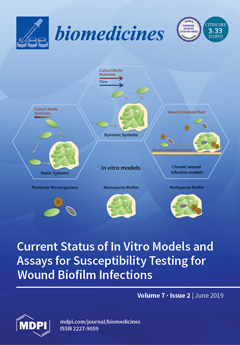HGF (hepatocyte growth factor)/HGFR (HGF receptor) signaling pathway is a key pathway in liver protection and regeneration after acute toxic damage.
Listeria monocytogenes toxin InlB contains a HGFR-interacting domain and is a functional analog of HGF. The aim of this work was to
[...] Read more.
HGF (hepatocyte growth factor)/HGFR (HGF receptor) signaling pathway is a key pathway in liver protection and regeneration after acute toxic damage.
Listeria monocytogenes toxin InlB contains a HGFR-interacting domain and is a functional analog of HGF. The aim of this work was to evaluate the hepatoprotective activity of the InlB HGFR-interacting domain. The recombinant HGFR-interacting domain InlB321/15 was purified from
E. coli. MTT (3-(4,5-dimethylthiazol-2-yl)-2,5-diphenyltetrazolium bromide) test was used to measure InlB321/15 mitogenic activity in HepG2 cells. Activation of MAPK- and PI3K/Akt-pathways was tracked with fluorescent microscopy, Western blotting, and ELISA. To evaluate hepatoprotective activity, InlB321/15 and recombinant human HGF (rhHGF) were intravenously injected at the same concentration of 2 ng·g
−1 to BALB/c mice 2 h before liver injury with CCl
4. InlB321/15 caused dose-dependent activation of MAPK- and PI3K/Akt-pathways and correspondent mitogenic effects. Both InlB321/15 and rhHGF improved macroscopic liver parameters (liver mass was 1.51, 1.27 and 1.15 g for the vehicle, InlB321/15 and rhHGF, respectively,
p < 0.05), reduced necrosis (24.0%, 16.18% and 21.66% of the total area for the vehicle, InlB321/15 and rhHGF, respectively,
p < 0.05). Obtained data suggest that InlB321/15 is a promising candidate for a tissue repair agent.
Full article






